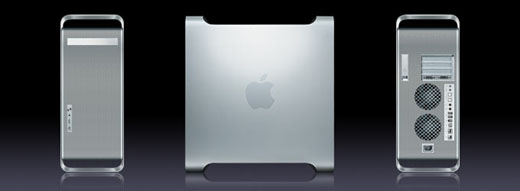No more mysteries: Apple's G5 versus x86, Mac OS X versus Linux
by Johan De Gelas on June 3, 2005 7:48 AM EST- Posted in
- Mac
Introduction
It is a professional 64 bit Dream machine with supersonic speed! It is beautiful. It is about the ultimate user friendliness. It is about a lifestyle. It is a class apart. You guessed it - I am parroting Apple’s marketing.For some reason, the performance of Apple’s gorgeous machines has been wrapped in a shroud of mystery. Yes, you could find a benchmark here and there, with one benchmark showing that the PowerMac is just a mediocre PC while another shows it off as a supercomputer, the unchallenged king of the personal computer world.

If you like a less performance-obsessed article about Apple, OS X and the G5, you should definitely give Anand’s articles in the Mac section on AnandTech a read...
In this article, you will find a pedal to the metal comparison of the latest Xeon DP 3.6 GHz (Irwindale), Opteron 250, Dual G5 2.5 GHz and Dual G5 2.7 GHz.
Scope and focus
Apple’s PowerMac is an alternative to the x86 PC, but we didn’t bother testing it as a gaming machine. Firstly, you have to pay a big premium to get a fast video card – as a standard, you get the ATI Radeon 9650 - even on the high-end PowerMacs. Secondly, there are fewer games available on this platform than on the x86 PC. Thirdly, hardcore gamers are not the ones buying Apples, but rather, creative professionals.So, we focus on workstation and server applications, especially the open source ones ( MySQL, Apache) as Apple is touting heavily on how important their move to an “open source foundation” is.
The 64 bit Apple Machines were running OS X Server 10.3 (Panther) and OS X Server 10.4.1 (Tiger), while our x86 machines were also running a 64 bit server version of a popular Open Source Operating Unix system: SUSE Linux SLES 9 (kernel 2.6.5). We also included an older Xeon 3.06 GHz ( Galatin, 1 MB L3) running SUSE SLES 8 (kernel 2.4.19) just for reference purposes. Some of the workstation tests were done on Windows XP SP2.










116 Comments
View All Comments
exdeath - Friday, June 3, 2005 - link
Wow look at a 2.4 GHz Opteron clean house.I'd like to see what a 2.6 GHz FX-55 with unregistered memory would do ;) I'll be fair and say keep it at 2.6 GHz stock ;)
bersl2 - Friday, June 3, 2005 - link
Right. GCC 4.0 has an all new optimization framework, including autovectorization:http://gcc.gnu.org/projects/tree-ssa/vectorization...
Pannenkoek - Friday, June 3, 2005 - link
It is well known that GCC 3.3 can't vectorize code. However, GCC 4 should be able to, eventually if not already.The small cache of the G5 would hamper its server performance I'd reckon, regardless of other factors.
jimbailey - Friday, June 3, 2005 - link
I'm curious if you rebuilt Apache and MySQL from source. Apple has added significant amount of optimization to gcc and I would love to know if it has been included in this test. I don't doubt the results though. The trade off for using the Mach micro-kernel is well known.rubikcube - Friday, June 3, 2005 - link
Johan, I agree that all the facts point to your conclusions being accurate. I would bet all the money in the world that you are correct. However, this hypothesis is easily confirmed by running mysql on a G5 running linux.Olaf van der Spek - Friday, June 3, 2005 - link
> In Unix, this is done with a Syscall, and it results in two context switches (the CPU has to swap out one process for another)Does it?
As far as I know it doesn't. The page tables don't need to be swapped and neither does the CPU state. The CPU gets access to the kernel-data because it goes to kernel-mode, but that doesn't require a full context switch I think.
WileCoyote - Friday, June 3, 2005 - link
Tough crowd...Eug - Friday, June 3, 2005 - link
Of the stuff I understand, I agree with your conclusions, but I think it's reasonable to state that running Linux on the G5 yourself would have been the most definitive test.Anyways, I like fusion food. :)
cHodAXUK - Friday, June 3, 2005 - link
Great article, very educational read and it was very interesting to see what is holding the G5 back. IBM/Apple really need to address these issues, people are paying alot of money for G5's that are dilvering nowhere near the level of performance that they *theoretically* should be.Netopia - Friday, June 3, 2005 - link
WOW... great article.I too would like to see Yellow Dog (Or FC4) loaded on the G5 for a true head-to-head. I hope you have the time with the box to get 'er done!
Joe